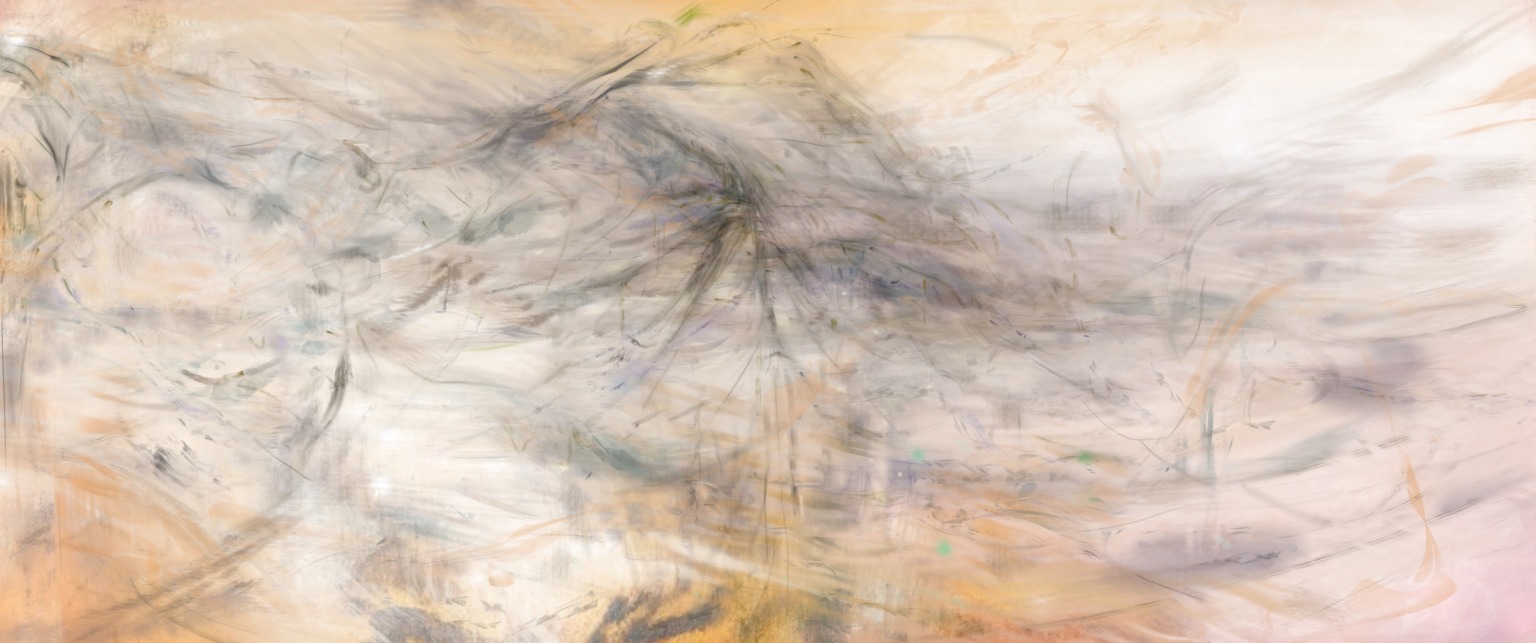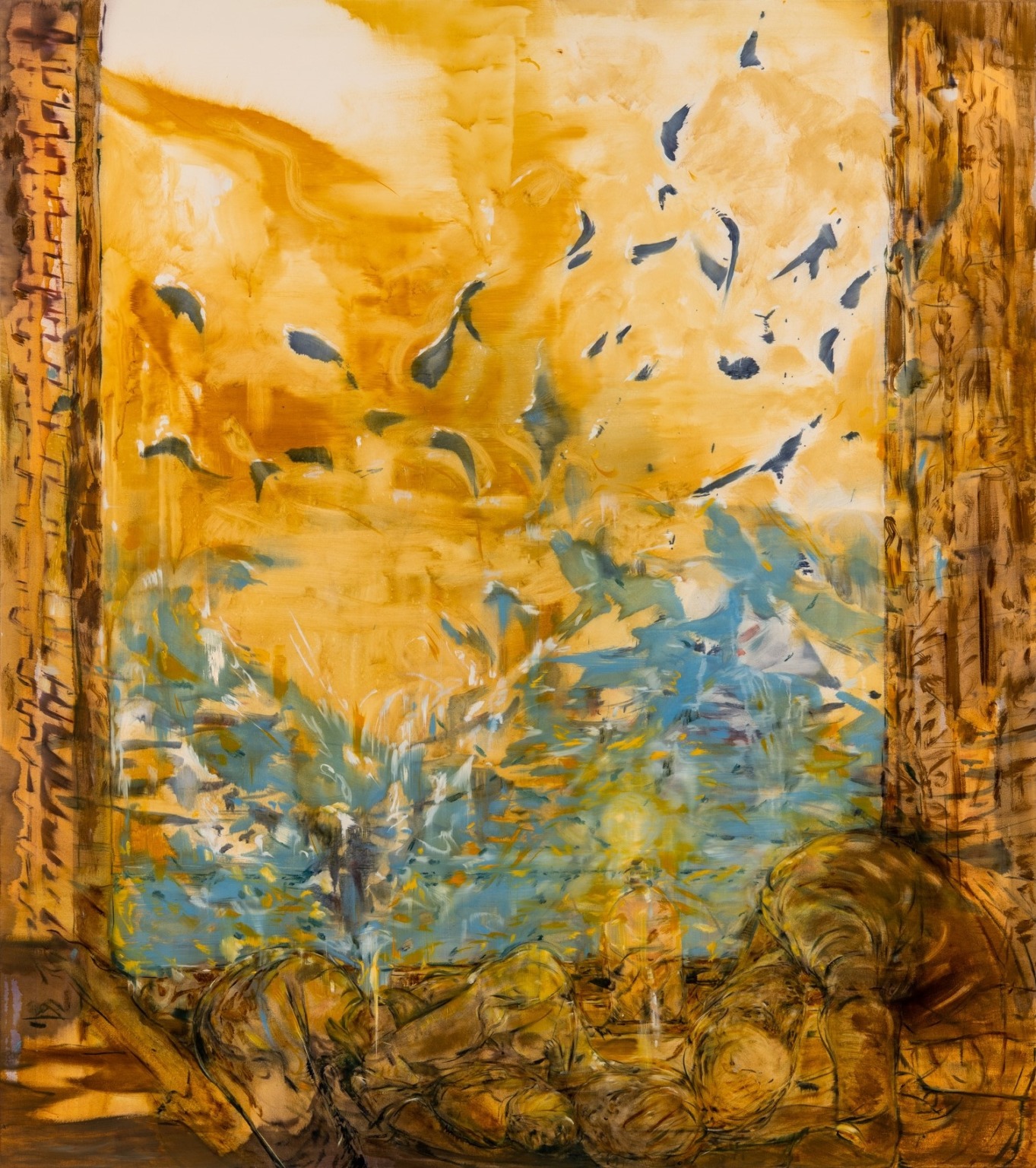2021 has been an exciting year for Bath based artist and a-n member Hannah Murgatroyd. The restrictions that lockdown imposed provided an opportunity to pause and reflect, leading to substantial changes in her approach to painting. She embraced a more open way of working and made her first digital paintings, expanding her practice in unanticipated new directions – all whilst balancing motherhood and a new baby.
Highly commended in the Contemporary British Painting Prize, Hannah also recently exhibited at nomadic art space OHSH Projects. Here she reflects on a busy 12 months and her hopes for 2022 with a-n Writer Development member Isaac Nugent.

What kind of a year has 2021 been for you?
It’s been a year of transformation. My work has undergone a profound shift. Over the last few years, the figure had taken precedent in my work, but I felt like the real painting was going on in the background. However, it’s very hard to shift something when you’ve got the expectations of others upon you.
I started 2021 on my knees really – I had little paid work, I’d lost my studio due to motherhood and the pandemic. I had no way of showing my paintings. I had a baby to look after and my body hadn’t recovered from birth. When you’ve got nothing – when you’re in obscurity – you have a lot of freedom. So, I thought: this is the time to make the change. I draw in a very open and instinctual way. I wanted to return that to the painting.
I was able to get a new studio in Bath, which is where I live. I think it was the spring when I started. I had some quite intense time in the studio over the summer and started to make the paintings that I wanted. I had it in mind that I would use some of the new work to enter the Contemporary British Painting Prize and see if it reached an audience. Just to make the shortlist was great and then it was lovely to get highly commended.

Has anything happened this year that you didn’t expect?
Beginning to paint digitally is not something I ever thought I’d do. Greg Rook invited me to make an NFT as part of a curated space he was doing on the digital art market SuperRare. It came at this point of crisis – I hadn’t been able to get into the studio for 11 weeks because my daughter was unwell. I made my first NFT at 5am, painting on the iPhone app Procreate with my finger in bed. It opened up this potential for lightness and openness, which I was looking for.
I kind of feel like we could claim this as a feminist form. It allows me to make work and to make some money in the deep throws of motherhood in the way that nothing else could – just with my iPhone on Procreate.

What has changed for the better?
I left behind any expectations of what I should do. My first time painting was back in 2009 when I was in Leipzig on a residency. And, I went back to that time and the paintings I was making there. After 2015, Instagram hugely changed the climate for painters. The validation I was getting was for this very figure centric work, so I went towards it, but it wasn’t making me happy. I felt that the painting had become almost picture-making. It wasn’t painting anymore.
I made a commitment to my work. I had a sense that really I have one opportunity to live, I need to make it the best way that I can. That meant only doing what felt right for my work. I suppose that’s also part of motherhood. I need to be the kind of person I want my daughter to admire, and that person is a true person. You need to be honest to your core and that’s reflected in the work.
What happened this year that you wish hadn’t happened?
On a personal level, my family has suffered a lot of loss. There’s been quite extreme grief and I wish that hadn’t happened for them. There are some members of my family that were suffering really badly mentally and they made their choice to end their life. For some people there’s real peace in that decision, but I wish it hadn’t happened.
My wishes go out to my family – that they weren’t in such pain and can find happiness and peace in the future. And, anyone else in the same situation. The mental health impact of the pandemic, as well as the physical, is going to be felt for so long. I hope we continue with a kindness to ourselves and to others as we come out of it.

What would you characterise as your major achievement this year and why?
For me, it’s this literal healing through painting. All these years of lost work – to use them to inform the things that I wanted to paint. The way I wanted to paint. And, for that risk to pay off – in the sense of feeling real freedom.
That voracious need for images on something like Instagram that we try and fulfil is in opposition to painting , which is a durational experience. It’s about time, sensation and emotion, but these aren’t things that easily occur within a few seconds of disposable looking.
How will this experience impact your work?
At this point, I’m thinking about the influence of painting digitally on the physical paintings: the quality of the digital work on the screen and how to translate that to the physical paintings.
It’s a curious notion, given that I’m also concerned with how the screen is very much about disposability. So, I’m trying to find a way to move from this disposable image into something more permanent. And, to develop an interrelationship between these two ways of working.
Is there anything you’d like to have done but haven’t?
I’d like a solo show in London, you know. It’s about time! I’d also like to take my daughter to meet her family in Denmark, which we haven’t been able to do because of Covid. I’d like to spend some time painting there. I feel a real pull towards Denmark. We were literally connected as a landmass at some point long ago.
What are you looking forward to in 2022?
I’m looking forward to the Contemporary British Painting Prize coming to London and people being able to see the work in person.

